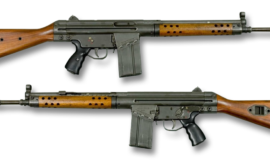he M249 Light Machine Gun (LMG), also known as the M249 Squad Automatic Weapon (SAW), is a highly versatile and reliable firearm used by the United States military. This belt-fed weapon is designed to provide sustained automatic fire to support infantry squads and is known for its effectiveness in various combat situations. Here’s an in-depth look at the M249, including its history, design features, operational use, and impact on modern military tactics.
Historical Background
The M249’s development began in response to the need for a reliable, light machine gun that could provide continuous fire support at the squad level. Before the M249, U.S. infantry squads primarily relied on the M60 machine gun and the M16 rifle, which lacked the sustained fire capability needed for effective suppression and support.
Development
- FN Minimi: The M249 is based on the FN Minimi, a Belgian-designed light machine gun produced by Fabrique Nationale (FN). The Minimi was introduced in the late 1970s and quickly gained a reputation for its reliability and firepower.
- U.S. Adoption: After extensive testing and evaluation, the U.S. military adopted the FN Minimi as the M249 SAW in 1984. The M249 was selected for its ability to provide sustained fire, its lightweight construction, and its compatibility with existing NATO ammunition.
Design and Features
The M249 LMG incorporates several design features that make it an effective tool for infantry squads:
Configuration
- Belt-Fed System: The M249 can fire from a disintegrating link belt, allowing for a high rate of sustained fire. It can also use M16-style magazines as a backup option, although this is less common due to reliability concerns.
- Caliber: Chambered in 5.56×45mm NATO, the M249 uses the same ammunition as the standard-issue M16 and M4 rifles, simplifying logistics and supply.
Fire Control
- Selective Fire: The M249 features a selective fire option, allowing the operator to switch between semi-automatic and fully automatic firing modes.
- Rate of Fire: The weapon has a cyclic rate of fire of approximately 700 to 850 rounds per minute, providing a high volume of fire for suppression and support.
Construction
- Materials: The M249 is constructed from a combination of steel, aluminum, and polymer components, balancing durability and weight.
- Weight: Weighing approximately 17 pounds (7.7 kg) unloaded, the M249 is light enough to be carried by individual soldiers yet heavy enough to manage recoil during sustained fire.
Features
- Quick-Change Barrel: The M249 includes a quick-change barrel feature, allowing operators to replace a hot barrel quickly and continue firing.
- Adjustable Bipod: The weapon comes with an integral, adjustable bipod for stabilized firing from prone or supported positions.
- Stock and Grip: The M249 is equipped with a fixed or collapsible buttstock and a pistol grip, designed for comfortable handling and control.
Operational Use
The M249 has been used extensively in various conflicts since its adoption, proving its effectiveness and versatility in numerous combat situations:
Deployment
- Infantry Support: The primary role of the M249 is to provide fire support at the squad level, enabling suppression of enemy forces and enhancing the squad’s overall firepower.
- Versatility: Its ability to use both belt-fed ammunition and magazines allows it to be used in diverse combat scenarios, from sustained engagements to rapid, mobile operations.
Combat Performance
- Reliability: The M249 has demonstrated high reliability under combat conditions, withstanding harsh environments and extended periods of use.
- Effectiveness: The combination of high rate of fire, portability, and ease of use makes the M249 an effective support weapon for small units.
Variants
Several variants of the M249 have been developed to meet specific operational needs:
- M249 Para: A shorter, lighter version with a collapsible stock, designed for airborne and special operations forces.
- M249 SPW (Special Purpose Weapon): A variant with a lighter barrel and reduced overall weight, intended for special operations.
- M249 PIP (Product Improvement Program): Includes various upgrades such as a new stock, improved bipod, and enhanced ergonomics.
Impact and Legacy
The M249 has had a significant impact on modern infantry tactics and small unit operations:
Tactical Advantages
- Sustained Firepower: The M249’s ability to deliver continuous, high-volume fire provides a crucial advantage in suppressing enemy forces and supporting maneuvering elements.
- Flexibility: Its compatibility with standard NATO ammunition and adaptability for different roles makes it a versatile asset for infantry squads.
Influence on Other Designs
- Modern LMGs: The success of the M249 has influenced the design and development of other light machine guns and squad automatic weapons, both within the U.S. military and among allied forces.
Conclusion
The M249 Light Machine Gun is a cornerstone of modern infantry firepower, offering a blend of reliability, portability, and sustained fire capability that is essential for effective squad-level support. Its innovative design and proven combat performance have cemented its place as a key asset in the U.S. military’s arsenal, demonstrating the importance of versatile and dependable support weapons in contemporary warfare.
